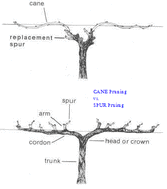From the Vineyard Part 2
Hello again and welcome to the second half of “from the vineyard” where I tell you oddly specific things about vines that you’ll never really need to know. But hey, there’s nothing like obscure knowledge to impress people with! So in that spirit, here’s a couple of questions someone asked me recently that I thought you all would like to know:
What are rootstocks? This is a fun fact to drop at cocktail (or wine) parties. Did you know that almost no vines are grown on their own roots anymore? Most vineyards are grafted onto the root system from a different grapevine outside of the Vitis vinifera species. This is due to the phylloxera pandemic of the 19th century that destroyed many vineyards in Europe. Phylloxera is a nearly microscopic insect that feeds on the root systems of vines, and is native to North America, meaning the phylloxera plague that destroyed Europe’s grapevines probably came from the U.S.’s nascent wine industry in the late 19th century (sorry Europe). However, since the pest is native to North America, the wild species of vines that grew here were often immune to phylloxera damage. This lead to the practice of grafting Vitis vinifera onto the root systems of vine species native to North America. Today, nurseries sell vines already grafted onto rootstocks of these other species, protecting our vineyards from phylloxera.
What is terroir? Terroir is a French word that translates into about a paragraph’s worth of English. Essentially it is the combination of soil, weather, sunlight, topography, viticulture practices and even local culture and customs acting on the vineyard to create flavors specific to a localized area. And that’s barely scratching the surface. Whenever you hear someone (such as us in numerous spots on this website) talking about representing an area and making a unique wine, they are speaking about terroir. My apologies to any Frenchmen (or Frenchladies) if I mistranslated.
And with that I hope everyone had a good thanksgiving and is looking forward to the end of the year. We’ll be back with more interesting information soon, I’m sure.
-Myles Lawrence-Briggs
What are rootstocks? This is a fun fact to drop at cocktail (or wine) parties. Did you know that almost no vines are grown on their own roots anymore? Most vineyards are grafted onto the root system from a different grapevine outside of the Vitis vinifera species. This is due to the phylloxera pandemic of the 19th century that destroyed many vineyards in Europe. Phylloxera is a nearly microscopic insect that feeds on the root systems of vines, and is native to North America, meaning the phylloxera plague that destroyed Europe’s grapevines probably came from the U.S.’s nascent wine industry in the late 19th century (sorry Europe). However, since the pest is native to North America, the wild species of vines that grew here were often immune to phylloxera damage. This lead to the practice of grafting Vitis vinifera onto the root systems of vine species native to North America. Today, nurseries sell vines already grafted onto rootstocks of these other species, protecting our vineyards from phylloxera.
What is terroir? Terroir is a French word that translates into about a paragraph’s worth of English. Essentially it is the combination of soil, weather, sunlight, topography, viticulture practices and even local culture and customs acting on the vineyard to create flavors specific to a localized area. And that’s barely scratching the surface. Whenever you hear someone (such as us in numerous spots on this website) talking about representing an area and making a unique wine, they are speaking about terroir. My apologies to any Frenchmen (or Frenchladies) if I mistranslated.
And with that I hope everyone had a good thanksgiving and is looking forward to the end of the year. We’ll be back with more interesting information soon, I’m sure.
-Myles Lawrence-Briggs



